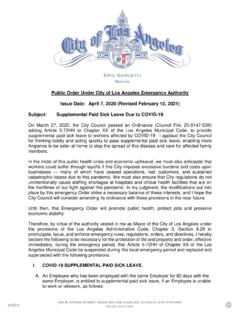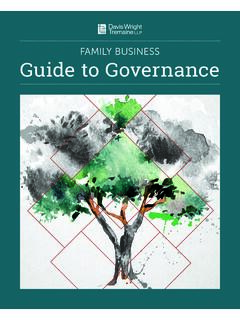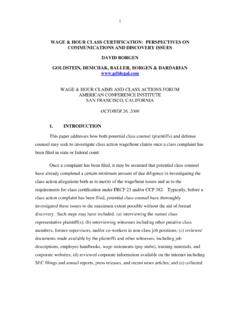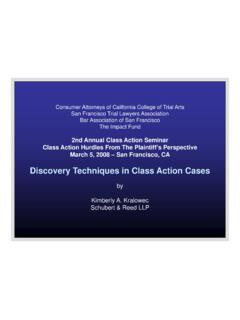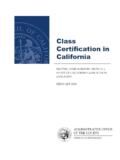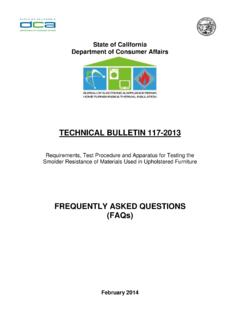Transcription of Litigating Class Actions Between Class Certification and Trial
1 CLICK ON EACH FILE IN THE LEFT HAND COLUMN TO SEE INDIVIDUAL no column is present: click Bookmarksor Pageson the left side of the window. If no icons are present: Click View, select Navigational Panels, and chose either Bookmarksor you need assistance or to register for the audio portion, please call Strafford customer service at 800-926-7926 ext. 10 Litigating Class Actions Between Class Certification and TrialEffectively Pursuing and Defending Pre- Trial Motions and Discovery RequestspresentsToday's panel features:Fred B. Burnside, Partner, Davis Wright Tremaine, SeattleTheresa L. Davis, Partner,Katten Muchin Rosenman, ChicagoElizabeth Chamblee Burch, Assistant Professor, Florida State University College of Law, Tallahassee, R. Karon, Partner, Goldman Scarlato & Karon, ClevelandTuesday, August 11, 2009 The conference begins at:1 pm Eastern12 pm Central11 am Mountain10 am PacificThe audio portion of this conference will be accessible by telephone only.
2 Please refer to the dial in instructions emailed to registrants to access the audio portion of the Live 90-Minute Audio Conference with Interactive Q&A1 DWT 13021150v1 0060664-000001 Going the Distance: Litigating Class Actions Between Class Certification and Trial Fred B. Burnside Davis Wright Tremaine LLP, Seattle WA August 11, 2009 I. INTRODUCTION AND OVERVIEW .. 1 II. DRAFTING THE Class Certification ORDER FINDINGS OF FACT AND CONCLUSIONS OF LAW .. 1 III. RECONSIDERATION AND 2 A. Motion for Reconsideration .. 2 B. Petition for Appellate 2 IV. DISCOVERY CONSIDERATIONS .. 3 A. Create a Formal Discovery Plan .. 3 B. Bifurcated Discovery: Shifting From Class Certification to Merits 4 1. Discovery to Narrow Plaintiffs Claims .. 5 2. Defending Against Rule 30(b)(6) Deposition 6 3. Expert Discovery: From Theory to Practice.
3 6 V. POST- Certification MOTIONS .. 7 A. Motions for Partial or Total Summary Judgment .. 7 B. Motion to Compel a Trial Plan .. 8 C. Motion for Decertification ..9 1. A New Judge May Be Less Willing to Try a Class as 10 2. Amendment of the Complaint Invites a Decertification Motion .. 11 3. Inability to Provide Appropriate Class Notice Warrants Decertification .. 11 VI. PREPARING FOR 12 A. Motions in 12 B. Motion to Bifurcate the Trial .. 13 C. Jury 14 VII. 14 1 DWT 13021150v1 0060664-000001 I. INTRODUCTION AND OVERVIEW While many materials exist addressing Class - Certification motion practice and how to try Class Actions , scant commentary exists concerning what occurs (when settlement doesn t) Between Class Certification and Trial . Oftentimes, counsel put all their eggs in the Class - Certification basket, giving little thought to post- Class - Certification strategy.
4 But cases don t always settle simply because the court has certified a Class , meaning counsel must consider post- Certification litigation concepts, whether involving procedure ( , undoing the court's Class - Certification order) or substance ( , completing discovery, moving for or opposing summary judgment, and preparing for Trial ). Without appreciating the full array of Class - action litigation issues, counsel can t properly represent their clients, even before Class Certification occurs. II. DRAFTING THE Class Certification ORDER FINDINGS OF FACT AND CONCLUSIONS OF LAW Often times courts will grant or deny the Class Certification motion (or the motion to strike Class allegations) at oral argument assuming you get oral argument. It is difficult at that moment to swallow your pride and begin to advocate again (rather than run from the room cursing), but you must do so immediately, and without apology. Consider the Court s oral ruling as an opening offer, and plan in advance for ways to narrow or better shape the Class definition, subclasses, or limit the claims actually certified.
5 Often times you will have given much more thought to the nuances and scope of the Class than has the Court or plaintiffs counsel, and a Court may be willing to certify, but may have unarticulated reservations about the scope of the Class that can shape then and there. It is best to use short, affirmative statements: , So you re certifying X claim, as to X people, but you re not certifying Y claims, as to Y people, right? Also, if you ve made evidentiary objections in the briefing, get rulings on those objections and motions now, as it will be too late to do so later, and you ll want those rulings for any appeal. Because a narrowed Class is not typically briefed most defense counsel go for all or nothing you may suggest that the Court hold off on entering an Order until it can review proposed findings and conclusions from both parties. Although the defendant has, at this point, lost, this is a valuable opportunity to limit the scope of the Class or to better position the defendant for appeal.
6 Indeed, cases show that well-crafted findings and conclusions are essential for meaningful appellate review. See Hartman v. Duffey, 19 1459, 1474 ( Cir. 1994) ( the paucity of the record on the question of appropriate Class Certification effectively precludes us from performing our reviewing task ); Silber v. Mabon, 18 1449, 1455 (9th Cir. 1994) (reversing as abuse of discretion district court refusal to excuse belated opt-out in part because district court failed to identify bases for its ruling). A party s proposed findings and conclusions, if adopted, are entitled to the same deference that a judge s independent order. See Anderson v. Bessemer City , 470 564, 572 (1985) ( even when the Trial judge adopts proposed findings verbatim, the findings are those of the court and may be reversed only if clearly erroneous ); Petrovic v. Amoco Oil Co., 200 1140, 1150 (8th Cir. 1999) ( even a verbatim adoption of proposed findings of fact does not change the standard of review ).
7 2 DWT 13021150v1 0060664-000001 Once proposed findings and conclusions are submitted, it is entirely appropriate for a defendant to: (a) submit objections to plaintiffs proposed findings and conclusions of law; and (b) submit alternate proposed findings and conclusions that posture the case in a better light for the defendant. In my experience, plaintiffs counsel tend to overreach ( , findings never made, arguments never raised, etc.) when courts ask for these, and defense counsel need to be vigilant in addressing that overreaching. In submitting objections to proposed findings and conclusions, your credibility is essential do not overreach, and cut issues you lost on. That said, if plaintiffs changed their Class definition or theory of liability in their reply brief which happens not infrequently it is (in my opinion) acceptable to point out that fact, explain what your response would have been, and craft a proposed finding or conclusion that reflects a more favorable approach for the defense.
8 This is akin to a motion for reconsideration, but should be limited to new areas/arguments raised on reply, such that the court is not reconsidering anything. I have seen courts reverse Certification orders through this process. III. RECONSIDERATION AND REVIEW A. Motion for Reconsideration Motions for reconsideration are disfavored, and to be candid, are rarely granted. That said, in the realm of Class Certification , plaintiffs theories of liability, Class definition, and evidence sometimes change dramatically in the reply brief, with no opportunity for the defendant to respond. Sometimes too, the Court may pick up on a small point in the briefing that the parties did not focus on, and to which additional briefing and analysis may be useful. Or the Court may not have ruled on an evidentiary issue or collateral motion that affects the Certification decision. Regardless, with due caution to the fact that you will be appearing before the same judge in this case (and likely many others), you may want to consider moving for reconsideration if for no other reason than to better position the issues and facts for appeal.
9 There is authority for the proposition that the standard for a reconsideration motion is more lenient in the Class context, as a result of the significant stakes involved in that decision, which is often the most significant decision rendered in these Class - action proceedings. Deposit Guaranty Nat l Bank v. Roper, 445 326, 339 (1980). This is because in the Class action context the usual reluctance to entertain motions for reconsideration simply does not apply. Slaven v. BP Am., Inc., 190 649, 651-52 ( Cal. 2000). An order certifying a Class is inherently tentative; the Court is charged with the responsibility to revisit Certification as the case develops. Id. at 652. In fact, some suggest that parties should present Certification concerns as soon as possible to avoid expending time and resources if a case should not proceed on a Class basis. Westways v. World Travel, Inc. v. AMR Corp., 265 Fed. Appx. 472, 476 (9th Cir. 2008) (Berzon, J.)
10 , dissenting in part). B. Petition for Appellate Review Federal Rule of Civil Procedure 23(f) permits a party on the losing end of a Class Certification motion (or decertification motion) to file a discretionary appeal, so long as the petition is filed within 10 court days from the date the Class Certification order is entered on the Court s docket. See Fed. R. Civ. Proc. 23(f).1 If a motion for reconsideration is filed within 10 1 Another avenue of appellate review is a writ of mandamus. Although an appeal under Rule 23(f) is a more likely avenue for review, nothing prevents a defendant from also seeking a writ of mandamus. Before Rule 23(f) was 3 DWT 13021150v1 0060664-000001 days of the Class Certification order, the 10 day period under Rule 23(f) begins to run from the date the reconsideration motion is denied. See, , Shin v. Cobb County Bd. Of Educ., 248 1061, 1064-65 (11th Cir. 2001).






